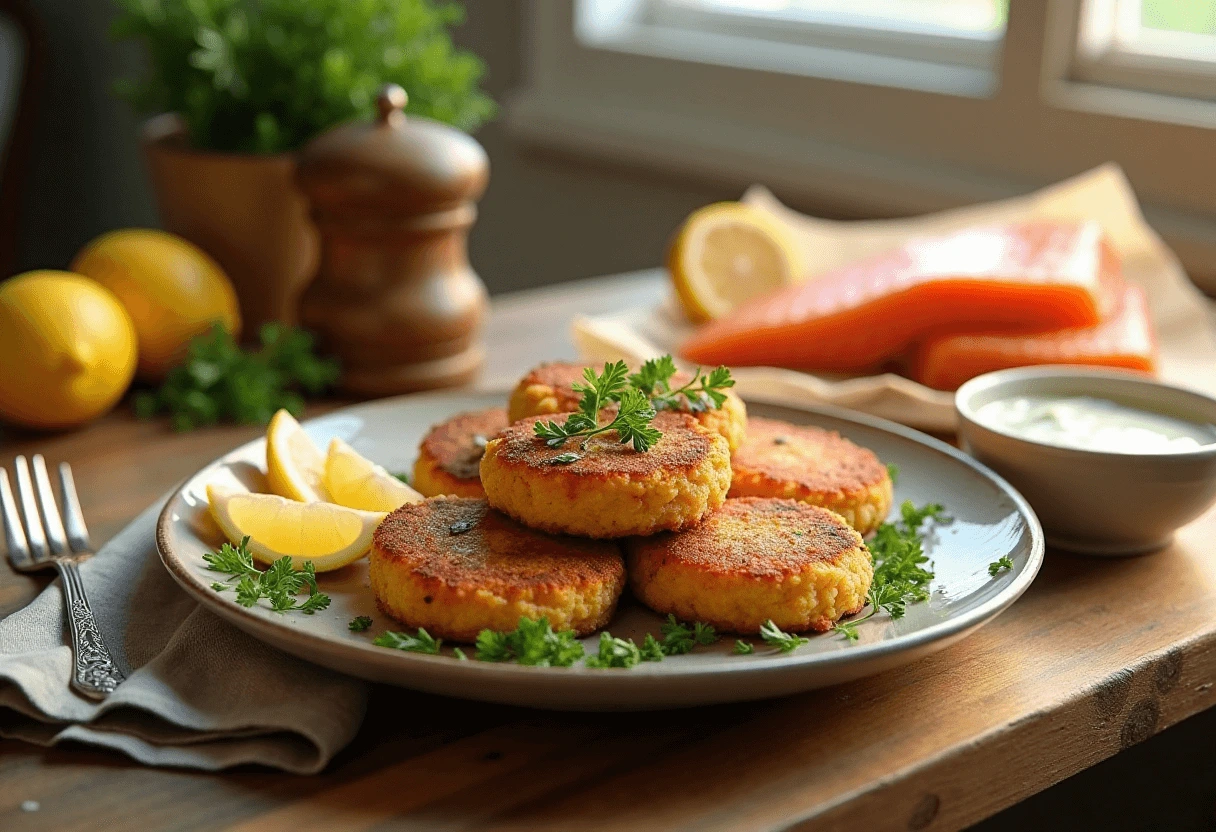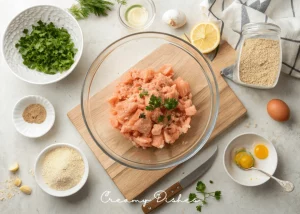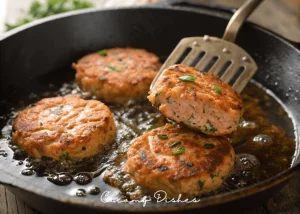Salmon cakes are a delightful dish that brings a perfect balance of flavor, nutrition, and convenience to your table. Whether you’re looking for a quick dinner option, a light lunch, or a crowd-pleasing appetizer, salmon cakes are incredibly versatile.
Whether you’re using fresh, canned, or leftover salmon, this recipe is flexible enough to suit your pantry and preferences. Follow along as I guide you through every step to create perfectly crispy salmon cakes that your whole family will love!
Why You’ll Love This Salmon Cakes Recipe
These salmon cakes are packed with protein, low in carbs, and full of healthy fats, which makes them a great choice for anyone seeking a nutritious meal.
You’ll also appreciate how quick and easy they are to prepare, taking less than 30 minutes from start to finish, perfect for those busy weeknights. Plus, they’re incredibly versatile, working equally well as a main dish, appetizer, or even a hearty side.
Best of all, the ingredients can be customized to suit different dietary needs, whether you need gluten-free breadcrumbs or prefer dairy-free add-ins.

Salmon Cakes Recipe
Ingredients
- 2 cups cooked salmon 400g or 14 oz can, drained
- 1 large egg
- 1/3 cup breadcrumbs 40g or almond flour
- 2 tablespoons finely diced onion 20g
- 1 clove garlic minced (5g)
- 1 tablespoon fresh parsley chopped (4g)
- 1 teaspoon Dijon mustard 5g
- 1/4 teaspoon paprika 0.6g
- Salt and pepper to taste
- 2 tablespoons olive oil for frying 30ml/27g
Instructions
- In a large bowl, flake the salmon with a fork until evenly shredded.2 cups cooked salmon

- Add egg, breadcrumbs, diced onion, minced garlic, chopped parsley, Dijon mustard, paprika, salt, and pepper to the bowl.1 large egg, 1/3 cup breadcrumbs, 2 tablespoons finely diced onion, 1 clove garlic minced, 1 tablespoon fresh parsley chopped, 1 teaspoon Dijon mustard, 1/4 teaspoon paprika, Salt and pepper to taste
- Mix all ingredients gently until well combined but not overmixed.
- Form the mixture into 6-8 evenly sized patties, about 3 inches wide each.
- Place the formed patties in the refrigerator to chill for 10 minutes.
- Heat olive oil in a large skillet over medium heat.2 tablespoons olive oil for frying
- Once oil is hot, carefully place the patties in the skillet.

- Cook for 3-4 minutes on each side until golden brown and crispy.
Notes
- For a gluten-free version, substitute breadcrumbs with almond flour or crushed gluten-free crackers
- Make ahead tip: Form patties and freeze uncooked for up to 3 months
- For best results, don’t skip the chilling step as it helps the patties hold their shape
- Use wild-caught salmon when possible for optimal flavor and nutrition
- Patties can also be baked at 375°F for 15-20 minutes, flipping halfway through
Creative Alternatives for Salmon Cakes
The question of how to prepare salmon cakes in numerous tasty forms leads to an array of potentially delicious variations. A unique twist for traditional salmon cakes comes from using multiple vegetable additions and alternative breadcrumb alternatives beyond onion-garlic-parsley bases. Shredded zucchini and carrots enable tasty additions with nutrients while creating color texture in the salmon cakes. A gluten-free substitute for breadcrumbs includes almond flour and crushed gluten-free crackers. The salmon patties emerge crisp on the outside while maintaining tender texture inside and deliver a magnificent salmon flavor note.
To reduce oil use in salmon cakes keep the oven temperature at 375°F when baking. This will provide a healthier preparation method. Oven-baked salmon patties achieve beautiful golden brown colors due to an olive oil coating before baking begins. These salmon pancakes deliver a perfect nutritional profile alongside great flavor alongside an option of a baked or pan-seared crispy finish.
My Personal Tips and Experience
I first tried making salmon cakes with canned salmon when I was short on time and, to my surprise, they turned out delicious.
The key is draining the canned salmon thoroughly and chilling the patties for at least 10 minutes to prevent them from falling apart. Mixing the ingredients gently helps maintain a delicate texture, and if the mixture feels too wet, a sprinkle of extra breadcrumbs will do the trick.
Thanks to salmon’s natural healthy fats and protein, these cakes are perfect for a quick dinner, light lunch, or even as an appetizer. Enjoy them in sandwiches, salads, or on their own—you’ll never run out of satisfying ways to serve these versatile patties!
FAQ
- How do you keep fish cakes from falling apart?
Ten minutes of patty cold storage represents the best method to prevent them from breaking when they cook. You should mix the ingredients very gently while avoiding overmixing the mixture. The mixture needs more breadcrumbs and almond flour to hold together which will keep the flavor intact. - Is it better to bake or fry salmon fillets?
The decision mainly rests between individual taste choices and health objectives. When making salmon you can get crispier results from frying it while baking creates a healthier outcome with reduced oil usage. The proper use of these two cooking methods ensures moist salmon throughout the dish so you should decide between baking and frying based on your time and equipment availability and texture goals. - Do you need to flip salmon when baking?
You typically do not require flipping during salmon baking. After placing your salmon on the pan with the skin-side facing down or without the skin you should experience uniform cooking throughout the whole piece in your oven. Switching to the broil setting during final cooking minutes provides additional color but proper flipping is optional for baking salmon fillets.
You May Also Like:
How to Make a Perfect Air Fryer Salmon recipe in Just 15 Minutes




3 thoughts on “How to Make Salmon Cakes: A Step-by-Step Recipe Guide”